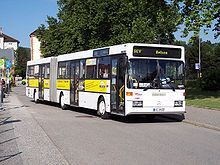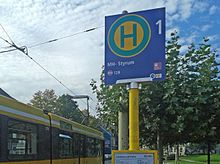Rail replacement services

Schienenersatzverkehr (abbreviated SEV ) bus replacement bus , bus replacement service , replacement rail (traffic) , Rail replacement (operation) , train set traffic or generally replacement bus ( EV ) refers to the use of buses and taxis instead of rolling at railways , S- or subways , city - or trams . For reasons of capacity, a train is often replaced by several road vehicles, which then often drive one behind the other within visual distance. In general, there are four types of rail replacement services:
Unplanned replacement rail service

If there are business interruptions as a result of accidents, floods, landslides, power outages, vehicle breakdowns, staff shortages, trees that have fallen on the route, heavy snowfall or the like, a so-called emergency bus service ( BNV ) must be organized for the affected section as soon as possible. It is particularly necessary if there is no suitable rail-bound diversion route for the railway or if there are no stops that can only be approached by rail replacement service.
Emergency taxi services or taxi replacement services can be set up at even shorter notice . Here, the relevant competent sends taxi office on behalf of and in close coordination with the concerned transport companies several taxis in areas affected by the interruption section. The use is possible for passengers with a valid ticket without additional costs, the billing takes place directly between the transport company and the taxi companies involved.
A major problem of spontaneous rail replacement traffic is for the transport companies to organize the necessary buses and drivers promptly and in sufficient numbers. In this context, for example, the Erfurt Railway , which only operates rail traffic, has already examined the purchase of its own buses for exclusive use in the event of disruptions in rail operations. In contrast, the Abellio company does not consider such a reserve to be economically feasible.
Planned rail replacement service
The planned rail replacement service is usually offered during construction work on a railway line. The railway company is not dependent on the usually relatively short nightly break in operation, so that larger measures can also be carried out. In addition, there are no night surcharges for construction workers, the lighting of the construction site or noise pollution for residents.
Due to the lead time, the corresponding replacement timetables for the planned replacement rail service can be communicated in good time by notices, the daily press or the Internet and the stations of the replacement service can be signposted. Often, such replacement services are scheduled for off-peak times, on the weekend or during school holidays or semester breaks , because then fewer passengers are on the road and buses can therefore be made available by the bus company more easily. In addition, knowing the rail replacement service, many passengers forego their journey entirely, look for other means of transport or go on foot, which means that the number of passengers continues to decrease compared to normal operations.
In city traffic, the replacement bus cannot always follow the direct rail route. Since the road itself is often closed during major track construction work, it often has to be led through parallel roads, which further extends travel times.
In replacement traffic on railway, S-Bahn and U-Bahn routes, various replacement services are now often offered in parallel. One bus runs non-stop for passengers with longer journeys between the beginning and the end of the line closure, while a second bus also drives to all intermediate stops in the blocked section and thus also serves the source and destination traffic in the blocked area.
Regular rail replacement service
The regular rail replacement service serves specifically to keep the high operating costs in rail traffic within limits, which is why some rail connections are operated in off-peak hours or off- peak times in rail replacement services. For example, the former Deutsche Bundesbahn ceased operations on many branch lines on Saturday lunchtime, after which there were alternative rail buses until Monday morning . Another example is the rack railway Stuttgart , the evening from 21 pm daily through line taxis will be replaced. Night buses are also frequently found on regular routes that cannot be offered by rail - for example due to a lack of appropriate track connections or turning options.
Permanent rail replacement service
The permanent rail replacement service, on the other hand, is not a temporary solution, but the successor to a railway line. In particular, less frequented branch lines have often been finally replaced by regional bus routes, because they may reduce operating costs. In the former GDR one spoke of the so-called change of mode of transport . Because this reduces comfort and travel speed ( rail bonus ), the number of passengers often falls so sharply that after a few years a rail replacement service is offered in the form of several short bus lines (continuous lines become branch lines ), taken over by call lines or completely abandoned. This process often takes years or decades, because only when a railway line is deedicated is its former operator finally released from the obligation to operate , only then does the replacement rail service become a regular bus service.
Mixed operation between regular traffic and rail replacement traffic
If there is a major shortage of vehicles in a tram company, there is the option of only serving certain circuits with buses. This means that rail and road vehicles alternate on the same line. The prerequisite for this, however, is that the tram line is continuously routed on grooved rails in the public street space or that the replacement stops are at least within sight of the actual tram stops. Examples of this mode of operation are line 2 of the Ulm tram or the F Market & Wharves tram line in San Francisco , although in the latter case there are not enough trained tram drivers available. In earlier years, this mode of operation was also observed in the Bremerhaven tram in its final years of operation or in the Reșița tram in the first half of the 1990s.
Stops
As a rule, the buses of the rail replacement service - if available - stop at existing bus stops . In the meantime, many rail transport companies are starting to signpost the potential stops for replacement traffic on a permanent basis. This is the case with the Munich S-Bahn , for example , so that it can be used at any time in the event of an unplanned replacement service.
General
In all cases it is disadvantageous that the continuous train connection is interrupted and comfort, orientation and information deficits can arise. The journey time is usually longer, and in addition, only the second carriage class is generally offered in replacement services, even if the train to be replaced normally also carries the first class. Likewise, the on- board toilet is usually missing in the replacement bus , and the transport of bicycles and the possibility of purchasing tickets are usually limited or excluded, and the overall transport capacity is often lower. Furthermore, vehicles for rail replacement services in rural regions often do not stop at the respective intermediate train stations , but at alternative bus stops along the respective local thoroughfare . In this way, time-consuming stub journeys are avoided. Sometimes, however, this can also be advantageous for passengers who are aware of the replacement traffic if the bus stop is cheaper for them than the train station. Typically, the replacement traffic is carried out by one or more subcontractors in what is known as contract traffic , since the railway company often does not have enough or no vehicles of its own to handle the replacement traffic itself.
According to Section 18d of the Railway Act, no separate license is required for rail replacement services in Austria , although a message is distributed on May 1st that line 180 via Semmering will be used once a year for this reason.
particularities
Replacement services for underground lines closed due to construction work are sometimes also carried out by trams , for example in Vienna, when the U6 line was partially closed in 2011, a replacement line E ran on the parallel tramway, and when the U1 line was partially closed in 2012 the two replacement tram lines 66 and 68 were set up, which served the areas of the blocked subway section. In both cases there were no buses.
In some other cities, too, the respective replacement traffic is signposted with the additional letter E known from e-cars , whereby, for example, a tram line 1 runs on the section not affected by the closure, while an additional bus line 1E or E1 replaces the tram in the non-passable section . Another alternative is to use a deleted line signal for replacement traffic.
See also
literature
- Florian Kühne: Rail replacement traffic in regional planning · with special consideration of local public transport along disused local rail routes of the former German Federal Railroad in rural areas . Diss. Univ. Dortmund 2000, ISBN 978-3-8311-1046-9 .
Web links
Individual evidence
- ↑ Tino Zippel: Help passengers faster in the event of an accident: Erfurter Bahn is looking into purchasing its own replacement buses , article in the Ostthüringer Zeitung of January 17, 2019, online at otz.de, accessed on January 25, 2019
- ↑ Joe Fitzgerald Rodriguez: Historic Muni streetcar shortage highlights driver training woes , September 8, 2016 article in the San Francisco Examiner, online at sfexaminer.com, accessed December 22, 2018
- ↑ Line 180: Bus only runs once a year on ORF from May 1, 2017, accessed on May 1, 2017
- ^ Veste buna de la RATT! Se prelungeste traseul unui autobuz din Timisoara , article on opiniatimisoarei.ro from 25 August 2014


